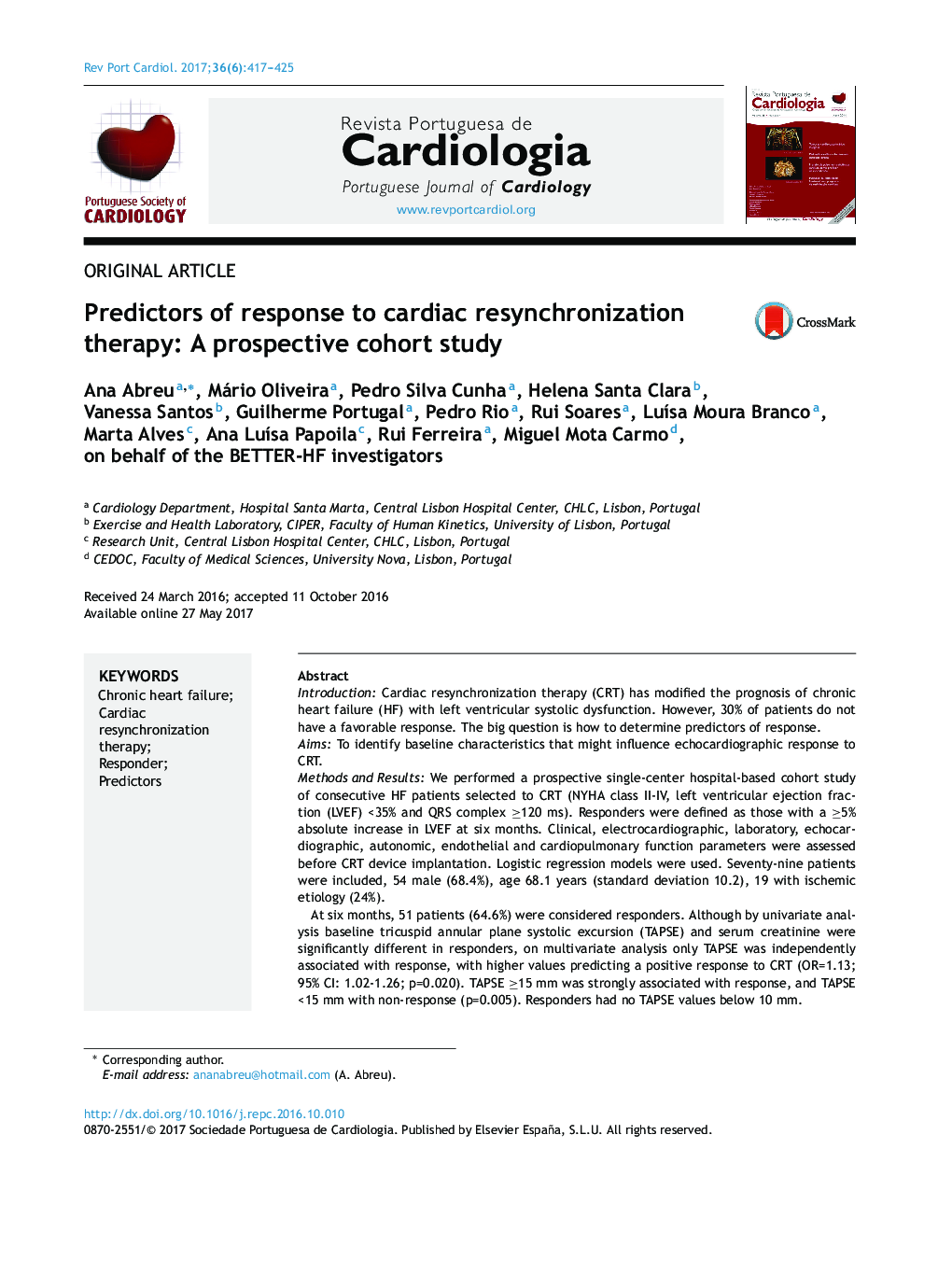| کد مقاله | کد نشریه | سال انتشار | مقاله انگلیسی | نسخه تمام متن |
|---|---|---|---|---|
| 5126399 | 1378496 | 2017 | 9 صفحه PDF | دانلود رایگان |

IntroductionCardiac resynchronization therapy (CRT) has modified the prognosis of chronic heart failure (HF) with left ventricular systolic dysfunction. However, 30% of patients do not have a favorable response. The big question is how to determine predictors of response.AimsTo identify baseline characteristics that might influence echocardiographic response to CRT.Methods and ResultsWe performed a prospective single-center hospital-based cohort study of consecutive HF patients selected to CRT (NYHA class II-IV, left ventricular ejection fraction (LVEF) <35% and QRS complex â¥120 ms). Responders were defined as those with a â¥5% absolute increase in LVEF at six months. Clinical, electrocardiographic, laboratory, echocardiographic, autonomic, endothelial and cardiopulmonary function parameters were assessed before CRT device implantation. Logistic regression models were used. Seventy-nine patients were included, 54 male (68.4%), age 68.1 years (standard deviation 10.2), 19 with ischemic etiology (24%).At six months, 51 patients (64.6%) were considered responders. Although by univariate analysis baseline tricuspid annular plane systolic excursion (TAPSE) and serum creatinine were significantly different in responders, on multivariate analysis only TAPSE was independently associated with response, with higher values predicting a positive response to CRT (OR=1.13; 95% CI: 1.02-1.26; p=0.020). TAPSE â¥15 mm was strongly associated with response, and TAPSE <15 mm with non-response (p=0.005). Responders had no TAPSE values below 10 mm.ConclusionFrom a range of clinical and technical baseline characteristics, multivariate analysis only identified TAPSE as an independent predictor of CRT response, with TAPSE <15 mm associated with non-response. This study highlights the importance of right ventricular dysfunction in CRT response.ClinicalTrials.gov identifier: NCT02413151.
ResumoIntroduçãoA terapêutica de ressincronização cardÃaca (CRT) modificou o prognóstico da insuficiência cardÃaca (HF) com disfunção ventricular esquerda. Contudo, 30% dos doentes não são respondedores. A grande questão está em identificar preditores de resposta.ObjetivosIdentificar caracterÃsticas basais que podem influenciar a resposta ecocardiográfica à CRT.Metodologia e resultadosEstudo cohort prospetivo, unicêntrico, hospitalar, de doentes consecutivos com HF selecionados para CRT (classes II-IV NYHA, fração de ejeção ventricular esquerda <35% e QRSâ¥120 mseg).Os respondedores foram definidos por aumento absoluto de fração de ejeção ventricular esquerda â¥5% aos 6 meses.Antes da implantação do ressincronizador, foram avaliados parâmetros clÃnicos, eletrocardiográficos, laboratoriais, ecocardiográficos, autonómicos, endoteliais e funcionais cardiorrespiratórios. Utilizaram-se modelos de regressão logÃstica.IncluÃram-se 79 doentes, 54 masculinos (68,4%), idade 68,1 (SD=10,2) anos, 19 isquémicos (24%). Aos 6 meses, consideraram-se respondedores 51 doentes (64,6%). Apesar de, por análise univariável, a excursão sistólica do plano do anel tricúspide (TAPSE) e a creatinina sérica serem significativamente diferentes nos respondedores, em análise multivariável, apenas TAPSE foi independentemente associada a resposta, sendo valores superiores preditivos de resposta positiva à CRT (OR=1,13; 95% CI: 1,02-1,26; p=0,020). A TAPSEâ¥15 mm teve forte associação com resposta, enquanto TAPSE<15 mm a não resposta (p=0,005). Respondedores não tiveram valores de TAPSE inferiores a 10 mm.ConclusãoDe um conjunto de caracterÃsticas basais clÃnicas e técnicas, a análise multivariável apenas identificou TAPSE como preditor independente de resposta a CRT, associando TAPSE<15 mm a não resposta. Este estudo destaca a importância da disfunção ventricular direita na resposta à CRT.ClinicalTrials.gov identifier: NCT02413151.
Journal: Revista Portuguesa de Cardiologia - Volume 36, Issue 6, June 2017, Pages 417-425